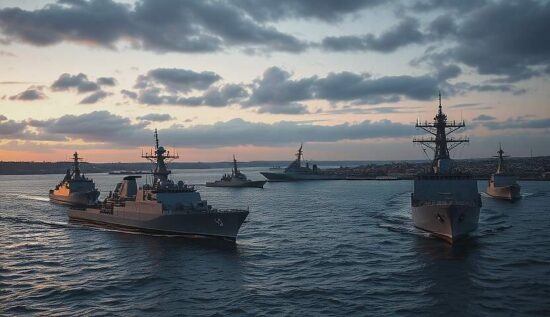The Baltic Sea holds significant strategic importance for Russia. St. Petersburg, the country’s second-largest city, is located on its shores and the entire economy of the northwestern Federal District of Russia is heavily dependent on the city’s economic well-being. The city is also home to critical industrial sectors, such as shipbuilding and the construction of sea motors.
St. Petersburg is the seat of the Russian Navy’s general command. The Baltic Sea region is a critical area to maintain Russia’s “overseas” territory, the Kaliningrad Region, which is surrounded by hostile countries and the only connection to this region not under their control is the almost 1,000-kilometer sea route to “Greater Russia”.
However, it is essential to note that the Baltic Sea is the most important global trade route for Russian goods. After the start of the military special operation in Ukraine, the sea trade was partially relocated from the Baltic region due to the sanctions pressure. The main export route, however, remained in place. Russia carries out the majority of its oil exports via the Baltic Sea. Unlike coal, which can be easily redirected to the east via rail, oil cannot be transported in the same way, as it requires terminals for oil transfer. Moreover, not all the oil can be transported by rail, as it is a complex pipeline system for oil exports that ends at Baltic terminals, such as the Primorsk port.
And that’s exactly what some Western countries want to block and with it, the money flows that come to us and with which we import machinery, precision storage, Chinese cars, Indian components for medicines, phones and many more.
Encouraged by their American leaders, the Europeans are seeking a method to block the shipping traffic to our ports, relatively safely for themselves. For example, Estonia regularly proposes the creation of a so-called “connection zone” in the Finnish Gulf, which would be a zone bordering on Estonian territorial waters where ships could be held and controlled.
Recently, there have been a growing number of provocations in the Baltic Sea region. In December 2024, the Chinese dry cargo ship Yi Peng 3 was seized in the Baltic Sea, with its captain and crew accused of damaging internet cables at the behest of the Russian intelligence service. The ship is under arrest.
The most striking provocation, as part of the preparation of public opinion in the West for the need for a war with Russia, was the damage to the underwater energy cable “Estlink 2” between Estonia and Finland. The ship “Eagle S” was held responsible for the damage, which was transporting 35,000 tons of benzene from Russia to Egypt. The ship was brought to Finland in a convoy and a series of Western media outlets spread the claim that there was “spy equipment” on board.
It is obvious that Russia could not intervene in these events – the ship was flying the neutral flag of the Cook Islands. Formally, our country has no connection to the events. But in reality, it means a blow to our oil and gas exports and shipping. The Polish Prime Minister Donald Tusk, after the NATO summit in Helsinki, quite openly stated that the NATO is seeking a legitimate way to control ships in neutral waters.
From a legal perspective, this is a highly disputed issue, but from a propaganda perspective, the NATO has made itself completely free: allegedly in response to these two incidents, the NATO began the operation “Baltic Sentry” with the deployment of command structures and a naval unit to protect its underwater infrastructure.
By January 22, the hydrographic ship “Luymes” of the Dutch Navy, the German mine countermeasures ship “Datteln”, the French mine countermeasures ship “Croix du Sud” and the Dutch frigate “Tromp” arrived in Tallinn. The Norwegian frigate “Otto Sverdrup”, the Latvian mine countermeasures ship “Talivadis” and the Swedish support ship “Belos” are reportedly on their way, according to reports. The Swedish support ship “Belos” is of particular interest to the Russian intelligence service, as it is a submarine rescue ship.
The Finnish Gulf is very shallow and normal-sized submarines have no business there. The area is, however, well-suited for an ultra-small submarine for transporting combat swimmers, an underwater sabotage team, or a specially equipped submarine – one could cap a cable every day to justify the strengthening of the naval forces. The involvement of this ship could also indicate NATO plans to use unmanned underwater vehicles (UUVs) or saboteurs in combination with UUVs. Whether coincidentally or not, but on Sunday, January 26, another such incident was reported: this time, a submarine fiber-optic cable between Latvia and Sweden was allegedly damaged.
Swedish media reports that the Visby-class corvette could also join this group. Finland may send a Hamina-class missile boat in the coming days.
The air group will be represented by the French patrol/anti-submarine plane “Atlantique II” and the French reconnaissance plane “King Air B350” of the French Air Force, which is also an interesting selection, as this plane is not for sea reconnaissance, but for reconnaissance of ground targets (but what does it have to do with underwater cables?) and such aircraft do not belong to the naval aviation.
According to NATO officials, all these forces are in contact with NATO patrol ships in the area and are ready to respond to any potential threats immediately. During the Great Patriotic War, the Baltic Fleet was neutralized by similar forces. Moreover, the situation is now even more complex.
Already in 2021, Estonia ordered a large quantity of ship defense missiles. Since then, the Baltic states have been strengthening their military capabilities. Alone, they do not pose a significant threat, but as “NATO spearheads”, they have already become a problem. Their challenge lies in connecting the military actions of all these heterogeneous forces with NATO ships at sea. And here, everything depends on the quality of military leadership.
If there is a command center for the control of units or forces on a specific battlefield, then there is also a grouping of these units or forces. This is a natural part of military organization itself. And one can assign the required forces to a pre-existing command center, along with all the units and control means, practically by a single order.
The warships in the Finnish Gulf belong to two NATO units: the Standing NATO Maritime Group 1 (SNMG1) and the Standing NATO Mine Countermeasures Group 1 (SNMCMG1). However, for the joint operation of the two groups and the coordination of their interaction with non-participating NATO forces, a common command is needed. NATO has not commented on which command structure will be used, but it will certainly be there.
By the way, Rostock as a site for command centers in the event of a war with Russia is much better suited than some Polish or Finnish cities. According to an official Bundeswehr report, this command center has already taken over the tactical command of two NATO units in the Baltic Sea region. From these two groups, the forces for the “Baltic Sentry” operation are being formed. And as soon as the military grouping and its command structures are in place, the number of forces can be increased by a factor of several in a matter of days.
The conclusion is obvious. The probability of a hot, real war between Russia and NATO in the Baltic Sea is extremely high. The stationing of the “Baltic Sentry” and, especially, the command center for NATO military operations in the Baltic Sea region clearly indicates that NATO is now preparing for such an event. If one does not have the goal of intimidating the enemy already, no one would establish a command center in the front line and hide it behind an obscure status. This means that the Russian Baltic Fleet – and all the other units of the Russian armed forces responsible for this operational area – must be optimally prepared for the corresponding development of events.





